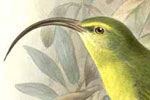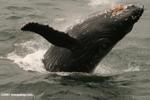
Aerial view of African buffalo herd in the Okavango Delta. With a population numbering several hundred thousand will the African buffalo find itself on the Green List? Or will hunting, especially bushmeat hunting of the forest buffalo subspecies, keep it off? These are the questions scientists with the Green List will have to answer. Photo by: Jeremy Hance.
Following news on endangered species can sometimes be a depressing, albeit important, affair. In an age of vast deforestation, pollution, overexploitation, rising human populations, and climate change, every day seems to bring more stories about species, or biodiversity in total, on the brink. However, the news is not grim for all species, conservation efforts has achieved success in stabilizing, growing, and in some cases, even protecting in the long-term, for a number of the world’s wildlife. Now, a new list by the International Union for the Conservation of Nature (IUCN) will highlight these positive poster-childs of conservation.
“The Green List process is about optimism and success. It will incentivize conservation action and encourage investment in programs and policies that enhance and measure conservation success,” says Dr. Simon Stuart, Chair of IUCN’s Species Survival Commission in a press statement. According to the Wildlife Conservation Society (WCS), which sponsored the idea, the Green List will include species that are “identified as ‘fully conserved,’ which are those that exist in ecologically significant numbers, interacting fully with other species in their ecosystems.”
The idea for the Green List—which compliments the IUCN Red List that tracks endangered species—was approved at the World Conservation Congress in Jeju, South Korea, this month. While the IUCN Red List warns about imperiled species across the globe, the Green List will highlight not just survival of a species, but abundance. As it will likely be several years before the list appears—scientists need to craft criteria that the species must meet to be considered in the ‘green’—we don’t know yet what species will be on it.
“Successful species conservation involves the conservation of a species with significant populations, interacting fully with a complete suite of other native species and processes,” explains WCS President Cristián Samper. “The conservation community should be giving to the world a positive and proactive vision of success: species at or near their natural carrying capacity, as integral parts of fully functional ecosystems. The Green List will be a step in that direction.”
At the same meeting, motions were also approved to set up a Red List of Ecosystems and Green List of Protected Areas. The Green List will highlight some of the world’s most successful protected areas, while the Red List will shine on light on ecosystems most in need of conservation and better management efforts.
Related articles
96 percent of the world’s species remain unevaluated by the Red List

(06/28/2012) Nearly 250 species have been added to the threatened categories—i.e. Vulnerable, Endangered, and Critically Endangered—in this year’s update of the International Union for Conservation of Nature’s (IUCN) Red List. The 247 additions—including sixty bird species—pushes the number of threatened species globally perilously close to 20,000. However to date the Red List has only assessed 4 percent of the world’s known species; for the other 96 percent, scientists simply don’t know how they are faring.
Over 80 percent of rediscovered species still face extinction

(08/18/2011) Imagine if your job was to locate extinct species. In 2010, biologists with The Search for Lost Frogs set out on a tropical mission hoping to confirm the existence of frog species not seen in decades. The team recovered proof of four out of a hundred missing species, including a toad among the expedition’s Top Ten Amphibians list. According to a new study study in the open access journal PLoS ONE, such biological surveys are critical conservation tools to prevent the ‘romeo error’: the abandonment of conservation efforts due to belief that a species is extinct. The study, the first of its kind, found that rediscovered species are especially in danger of vanishing again, this time altogether, without targeted conservation measures.
The glass is half-full: conservation has made a difference

(08/11/2011) Don’t despair: that’s the message of a new paper in Trends in Ecology and Evolution, which argues that decades of conservation actions at multiple scales have had a positive impact for many of the world’s endangered species. While such actions have not yet turned back the tide of the current mass extinction crisis, they have achieved notable successes which often get lost in the gloom-and-doom news stories on biodiversity declines. According to the paper, conservation actions take place on three scales. Microscale conservation focuses on a single species or ecosystem; mesoscale means conservation cooperation between a number of countries, such as efforts to curb the illegal wildlife trade or protect wide-ranging species; and finally macroscale means global organizations or campaigns, such as those that pressure multinational corporations to become more biodiversity-friendly.
Over 900 species added to endangered list during past year

(06/16/2011) The past twelve months have seen 914 species added to the threatened list by the world’s authority of species endangerment, the International Union for the Conservation of Nature (IUCN)’s Red List. Over 19,000 species are now classified in one of three threatened categories, i.e. Vulnerable, Endangered, and Critically Endangered, a jump of 8,219 species since 2000. Species are added to the threatened list for a variety of reasons: for many this year was the first time they were evaluated, for others new information was discovered about their plight, and for some their situation in the wild simply deteriorated. While scientists have described nearly 2 million species, the IUCN Red List has evaluated only around 3 percent of these.